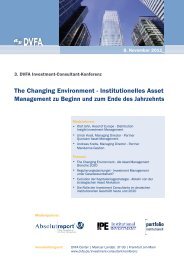KPIs for ESG - DVFA
KPIs for ESG - DVFA
KPIs for ESG - DVFA
Create successful ePaper yourself
Turn your PDF publications into a flip-book with our unique Google optimized e-Paper software.
The <strong>ESG</strong> management system serves to ensure that <strong>ESG</strong> activities in the defined fields are implemented at operational<br />
level and permits monitoring of these activities by the company management. Often a central <strong>ESG</strong> management<br />
committee is established, in which representatives of central <strong>ESG</strong>-related company functions regularly coordinate with<br />
the <strong>ESG</strong> representatives of the operative units and support the management board with respect to <strong>ESG</strong> issues. In<br />
many cases, there is a central <strong>ESG</strong> coordination office in place to support the <strong>ESG</strong> management committee in day-today<br />
business. The <strong>ESG</strong> management committee and the <strong>ESG</strong> coordination office ideally report directly to the CEO or<br />
the management board spokesman. Among other things, this serves to ensure the rein<strong>for</strong>cement function of <strong>ESG</strong><br />
management <strong>for</strong> the corporate strategy. Alternatively, an organisational tie-in with the Strategy unit or Compliance<br />
Management can be a good idea.<br />
The company should lay out its <strong>ESG</strong> management system with its key elements and processes to the capital market.<br />
Additional in<strong>for</strong>mation in the <strong>for</strong>m of organisational charts and descriptions of key functions can also be published<br />
online.<br />
CR management structure of RWE AG as of 31 December 2007<br />
Best practice example: organisational structure of <strong>ESG</strong> management<br />
As a rule, the fields of activity defined in the company’s <strong>ESG</strong> strategy are put into operation by way of an <strong>ESG</strong><br />
programme, which links them to concrete objectives and specifies <strong>ESG</strong> measures to meet these objectives. Generally,<br />
the company’s overall <strong>ESG</strong> objectives are communicated to the operative units in a top-down iterative process. The<br />
primary fields of <strong>ESG</strong> activity should be taken into account when defining objectives and initiating measures.<br />
Attainment of the objectives is monitored from the bottom up, and this monitoring process culminates in an<br />
assessment of the <strong>ESG</strong> results by the central <strong>ESG</strong> management committee.<br />
The company should provide a description of its overall <strong>ESG</strong> programme to the capital market. Additional reports on<br />
individual <strong>ESG</strong> projects with particular relevance <strong>for</strong> rein<strong>for</strong>cement of the corporate strategy may be published in the<br />
<strong>ESG</strong> report or online.<br />
For assessing the effectiveness of <strong>ESG</strong> activities and identifying needs <strong>for</strong> additional attention in areas previously<br />
deemed non-relevant, a systematic and early identification, collection and communication of relevant in<strong>for</strong>mation is<br />
required. Sources include internally generated data as well as in<strong>for</strong>mation on external events, such as the results of<br />
stakeholder dialogues, client and employee surveys or discourses with government authorities.<br />
Companies should also report on how they interact with members of their supply chain, e.g. how suppliers' adherence<br />
to minimum <strong>ESG</strong> requirements is reviewed and how customers are in<strong>for</strong>med about the company's <strong>ESG</strong> per<strong>for</strong>mance.<br />
The company should present its communication with stakeholders in an aggregated <strong>for</strong>m and highlight individual,<br />
especially relevant stakeholder relationships in the <strong>ESG</strong> report or via the Internet.<br />
Compliance with the <strong>ESG</strong> management system and its functioning must be continuously monitored. For instance, it<br />
would be possible <strong>for</strong> the internal audit department to review proper implementation of the <strong>ESG</strong> organisational<br />
requirements as part of its regular auditing duties. The central <strong>ESG</strong> coordination office could also the operative carry<br />
© <strong>DVFA</strong> April 2010 ALL RIGHTS RESERVED. No part of this publication may be reproduced, stored in a retrieval system, or transmitted, in any <strong>for</strong>m or by any<br />
means, electronic, mechanical, recording, without the prior permission of the copyright holder.<br />
6

















